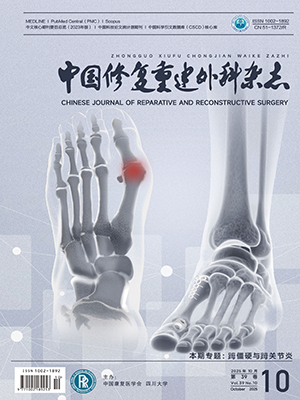| 1. |
Yan Q, Karau MJ, Greenwood-Quaintance KE, et al. Comparison of diagnostic accuracy of periprosthetic tissue culture in blood culture bottles to that of prosthesis sonication fluid culture for diagnosis of prosthetic joint infection (PJI) by use of bayesian latent class modeling and IDSA PJI criteria for classification. J Clin Microbiol, 2018, 56(6): e00319-18. doi: 10.1128/JCM.00319-18.
|
| 2. |
Li Z, Li C, Wang G, et al. Diagnostic accuracy of synovial fluid D-lactate for periprosthetic joint infection: a systematic review and meta-analysis. J Orthop Surg Res, 2021, 16(1): 606. doi: 10.1186/s13018-021-02778-8.
|
| 3. |
Ashley BS, Parvizi J. Current insights in the evaluation and treatment of infected total knee arthroplasty. J Knee Surg, 2021, 34(13): 1388-1395.
|
| 4. |
Bettiol P, Egan A, Cox C, et al. Pathological analysis of periprosthetic soft tissue and modes of failure in revision total joint arthroplasty patients. SAGE Open Med, 2021, 9: 20503121211047099. doi: 10.1177/20503121211047099.
|
| 5. |
Parvizi J, Jacovides C, Zmistowski B, et al. Definition of periprosthetic joint infection: is there a consensus? Clin Orthop Relat Res, 2011, 469(11): 3022-3030.
|
| 6. |
Osmon DR, Berbari EF, Berendt AR, et al. Diagnosis and management of prosthetic joint infection: clinical practice guidelines by the Infectious Diseases Society of America. Clin Infect Dis, 2013, 56(1): e1-e25.
|
| 7. |
Parvizi J, Tan TL, Goswami K, et al. The 2018 definition of periprosthetic hip and knee infection: An evidence-based and validated criteria. J Arthroplasty, 2018, 33(5): 1309-1314.
|
| 8. |
Yoshida H, Ochiai M, Ashida M. Beta-1, 3-glucan receptor and peptidoglycan receptor are present as separate entities within insect prophenoloxidase activating system. Biochem Biophys Res Commun, 1986, 141(3): 1177-1184.
|
| 9. |
周潔, 張穩燕, 孟勇. 靜脈注射不同濃度戊巴比妥鈉對兔麻醉死亡率的影響. 實驗動物科學, 2011, 28(6): 67-68.
|
| 10. |
叢銳軍, 符培亮, 劉偉, 等. 兔關節內植物植入術后金黃色葡萄球菌感染模型的建立. 中華關節外科雜志 (電子版), 2012, 6(6): 920-930.
|
| 11. |
López-Torres II, Sanz-Ruíz P, Navarro-García F, et al. Experimental reproduction of periprosthetic joint infection: Developing a representative animal model. Knee, 2020, 27(3): 1106-1112.
|
| 12. |
王勇平, 張懷斌, 謝瑞敏, 等. 新西蘭兔全膝關節置換術后假體周圍感染模型的建立. 中國實驗動物學報, 2021, 29(5): 657-663.
|
| 13. |
Slullitel PA, O?ativia JI, Buttaro MA, et al. State-of-the-art diagnosis and surgical treatment of acute peri-prosthetic joint infection following primary total hip arthroplasty. EFORT Open Rev, 2018, 3(7): 434-441.
|
| 14. |
馬瑞, 王家麟, 吳夢軍, 等. 關節置換后假體周圍感染病原菌分布及耐藥情況與治療周期的關系. 中國組織工程研究, 2021, 25(3): 380-385.
|
| 15. |
Schulz P, Dlaska CE, Perka C, et al. Preoperative synovial fluid culture poorly predicts the pathogen causing periprosthetic joint infection. Infection, 2021, 49(3): 427-436.
|
| 16. |
Ull C, Yilmaz E, Baecker H, et al. Microbial findings and the role of difficult-to-treat pathogens in patients with periprosthetic infection admitted to the intensive care unit. Orthop Rev (Pavia), 2020, 12(3): 8867. doi: 10.4081/or.2020.8867.
|
| 17. |
Ashida M. A cane sugar factor suppressing activation of prophenoloxidase in haemolymph of the silkworm, Bombyx mori. Insect Biochemistry and Molecular Biology, 1981, 11: 57-65.
|
| 18. |
Ashida M, Brey PT. Role of the integument in insect defense: pro-phenol oxidase cascade in the cuticular matrix. Proc Natl Acad Sci U S A, 1995, 92(23): 10698-10702.
|
| 19. |
Tsuchiya M, Asahi N, Suzuoki F, et al. Detection of peptidoglycan and beta-glucan with silkworm larvae plasma test. FEMS Immunol Med Microbiol, 1996, 15(2-3): 129-134.
|
| 20. |
Proctor RA, von Eiff C, Kahl BC, et al. Small colony variants: a pathogenic form of bacteria that facilitates persistent and recurrent infections. Nat Rev Microbiol, 2006, 4(4): 295-305.
|
| 21. |
Cyprowski M, Ławniczek-Wałczyk A, Górny RL. Peptidoglycans in cutting fluids-a good indicator of bacterial contamination? Ann Agric Environ Med, 2014, 21(2): 256-258.
|
| 22. |
Kobayashi T, Tani T, Yokota T, et al. Detection of peptidoglycan in human plasma using the silkworm larvae plasma test. FEMS Immunol Med Microbiol, 2000, 28(1): 49-53.
|
| 23. |
Inada K, Takahashi K, Ichinohe S, et al. A silkworm larvae plasma test for detecting peptidoglycan in cerebrospinal fluid is useful for the diagnosis of bacterial meningitis. Microbiol Immunol, 2003, 47(10): 701-707.
|
| 24. |
Shimizu T, Endo Y, Tabata T, et al. Diagnostic and predictive value of the silkworm larvae plasma test for postoperative infection following gastrointestinal surgery. Crit Care Med, 2005, 33(6): 1288-1295.
|




